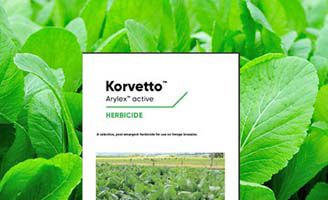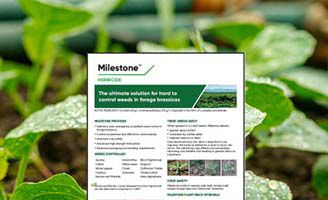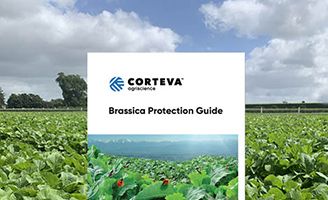Brassica herbicides
Corteva Agriscience marketing manager Glen Surgenor says there is an increasing emphasis on optimising crop performance, from day one.
Broadleaf herbicides from Corteva Agriscience such as Milestone®, Korvetto® and Radiate® are proven to be reliable tools to achieve this.
Milestone contains two active ingredients – aminopyralid at 60 g/L and clopyralid at 276 g/L. Both of these are well-recognised and widely used.
Glen says when Milestone was introduced it was a world-first.
“The formulation is sold overseas, but in no other country was it used for forage brassicas. It replaced our T-Max® product, and offered farmers greater crop safety which was a focus of the R&D team that created Milestone.
“By combining the two active ingredients, aminopyralid and clopyralid, Milestone provides exceptional control of thistles, and its weed spectrum includes wireweed, plantain and most other weeds from the T-Max label,” he says.
Although it was launched six years ago, Korvetto continues to find favour thanks to its unique package of benefits. It offers fast plant-back with control of hard to kill weeds like shepherd’s purse. It also provides superb crop safety.
“Plant-back is a standout feature of Korvetto. It is the most flexible post emergence herbicide for brassicas. It has a three month plant-back for clover and six month plant-back for fodder beet,” Glen says.
“This gives farmers more flexibility when planning subsequent crop rotations. Some other herbicide options have plant-backs that are 12-24 months, which can be quite limiting.”
Plant-back periods for maize, cereals, ryegrass and forage brassicas are nil; vegetables and legumes other than clover are six months.
Korvetto combines Corteva Agriscience’s new active Arylex® (Group 4) with the trusted chemistry of clopyralid (also Group 4), Glen says. This is the only formulation of its type for the forage brassica herbicide market.
As well as controlling key forage brassica weeds like fathen, nightshades and Californian thistles, at 1 L/ha Korvetto provides best-in-class control of shepherd’s purse and fumitory.
Crop safety is excellent for leafy and bulb turnips, kale, forage rape and swedes. Handling benefits include an in-built methylated seed oil (MSO) adjuvant, so there’s no need for farmers or contractors to add an oil adjuvant or surfactant to the mix.
Korvetto is safe to use after pre-emergence herbicides and should be applied to actively growing brassica crops when plants have reached the three to four leaf stage.
Radiate is older chemistry, with a narrower weed spectrum, but fills a useful role as a low-cost herbicide when customers need to get rid of fathen in their brassica crops.
Brassica Pests
Glen says when pests like diamondback moth, white butterfly, looper caterpillars or aphids threaten forage brassica crops, time is critical.
“Caterpillar pests can do significant damage to leaf area within a short space of time. Aphids transmit plant viruses and their feeding points provide entry wounds for diseases that can severely damage plants or even kill large areas of a brassica crop.”
Ideally the first line of defence will be a population of beneficial insects that give natural protection against white butterfly, diamondback moth caterpillars and aphids.
Species such as brown lacewing, ladybird beetles, hoverfly, parasitic wasps, predatory mites and beetles can play an important role in protecting brassica crops from pest flare ups and damage through until grazing.
Monitor your crop closely for both pests and beneficial insects and if caterpillar and/or aphid populations do flare up and require treatment, use insecticides with minimal impact on beneficial insects such as Corteva’s Sparta® and Transform®.
Sparta works by contact and ingestion to control caterpillars in forage brassicas. Translaminar activity ensures good control of insects feeding on the underside of leaves.
Transform is a contact and systemic insecticide that provides rapid knockdown and moves within the plant to protect new untreated growth.
Transform’s systemic and translaminar activity resists wash-off and provides aphid control for up to 21 days, which prevents them re-infesting the crop.
Alone or in combination Sparta and Transform are ideal tools for control of key insect pests in forage brassicas. Both products have excellent environmental and toxicology profiles, providing a high level of safety for applicators.
For further information contact your local Corteva Agriscience Territory Manager and always refer to the product label for further guidelines on timing and use.




